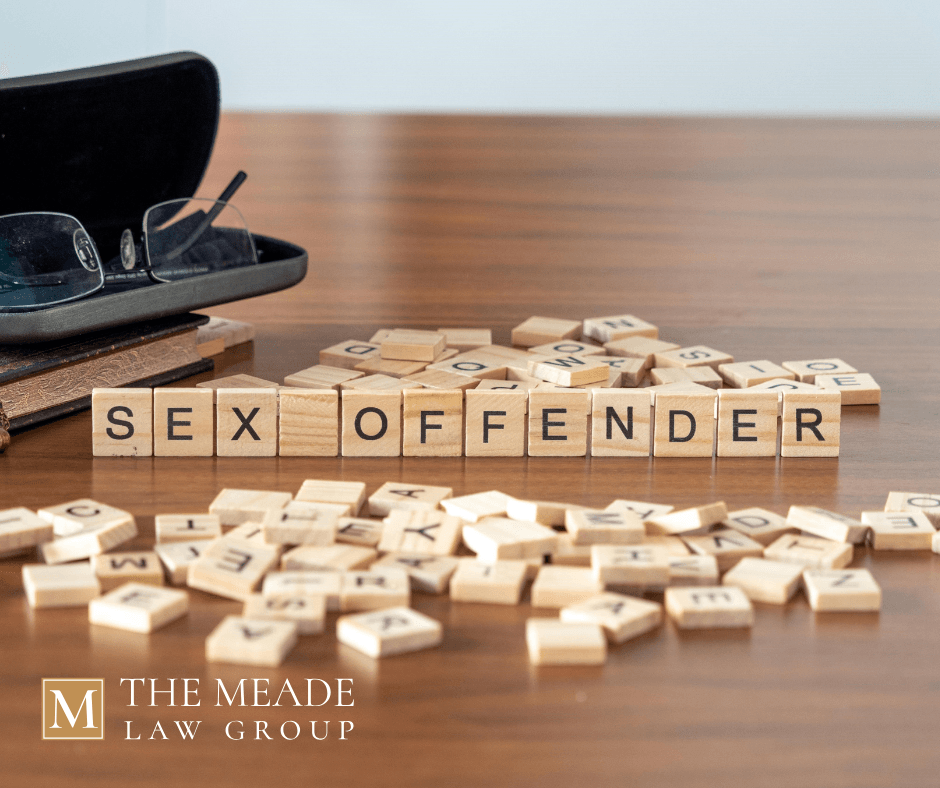Darren Meade
As criminal defense attorneys, we represent everyone, including some people who have done some bad things and made poor choices, then there are other times that you are unquestionably fighting for the good guy. This tale is of just such a case. This is one of those instances that reminds you why you became a criminal defense attorney to begin with.
The Stigma of a Sex Offender
In Ohio and many other states, when it comes to sex offender registration, it is equivalent to swatting flies with a sledgehammer. The general population thinks of a sex offender and immediately goes to the classic “child molester” stereotype of someone who is not fit for society and has deep rooted incurable issues.
The recurring questions are: what happens when the sex offender was young and impetuous as opposed to predatory? What happens when the sex offender was a hormone driven teenager—aka “a teenager”–with their younger teen significant other? Should that teen, barely an adult, have to carry a legal and on-line “child molester” label for literally decades to come? That was the fundamental issue of this case.
Background
This was a classic example of two teenagers meeting online and falling deeply in what teenagers refer to as love, but us adults refer to as lust. The unfortunate part was, he was 18, and she was 14. While such a Romeo and Juliet relationship is inappropriate and illegal, they believed they were in love and engaged in sexual relations. There was no force, coercion, use of intoxicants, or even grooming behavior involved. As much as a 14-year-old can be said to “consent” to sexual activity despite her relative immaturity, she did. In addition, the two had exchanged photo text messages. Her mother found out about the relationship, police were notified, and my client was ultimately convicted of F4 Unlawful Sexual Conduct with a Minor as well as F5 Disseminating Matter Harmful to a Juvenile.
Sentencing
At sentencing, the judge commented: “I think this is a terrible thing that I am required to put someone like you, who is no risk to the community on the sex offender registry. But the law says I have to do it.” That statement alone gives so much insight into the laws surrounding sexual offender cases. My client was sentenced to probation with several weeks in the work release program. Based on his perfect behavior, he was released from community control early. However, as the judge noted the client was also required to be entered into the sex offense registry as a Tier II offender for a period of 25 years.
A Determined Mother
They say that there is no love like the love a mother has for her child. That was truly proven here. My client’s mother, a real-estate attorney by trade, began lobbying in 2016 by meeting with as many interested parties as she could. This was no easy feat considering the stigma surrounding sex offenders. She met with the Ohio Sentencing Commission, the Ohio Judicial Conference, the Attorney General, and the Ohio Prosecuting Attorneys Association.
She solicited input from survivor groups and legislators and proposed draft legislation that mirrored a procedure in Alabama. The bill would allow an adolescent less than five years older than the minor, to petition to have his register terminated, provided there was no evidence of force, threat of force, or coercion. She began researching states which had programs to rehabilitate youthful offenders and allowed relief after proof of rehabilitation.
Challenges included: the age of the minor, the age gap, the use of the word “force,” and the potential for Ohio to lose JAG fund grants. She approached and ultimately gained the support of State Senator John Eklund (R-Geauga), a well-respected legislator and giant in Ohio criminal justice reform. After intensive investigation and seeking input from a variety of interested groups, Senator Eklund sponsored a bill that would eventually be enacted as R.C. Section2950.151, seeking to offer a select population of sex offenders the opportunity towards rehabilitation.
The next challenge: how do you define rehabilitation? She spent time with Senator Eklund and came up with a procedure that loosely followed the reclassification/ declassification of juveniles under O.R.C. 2152.84 and 2152.85. She spent the next five years making dozens, if not hundreds, of calls and trips to Columbus. She built a coalition, met with legislators, attended hearings, and testified in favor of Senate Bill 235 in 2018; and again, in favor of Senate Bill 47 in 2019.
She talked about the effect of “delayed adolescent brain development,” argued “the consensual nature of the offense,” and asked the legislators to allow these youthful offenders to achieve “redemption” and “become contributing members of society.” The key phrase was: “these adolescents made a mistake before they were old enough to buy a beer,” one which would require them to register until their mid-forties.
Legislation Passed, Time to File
Despite everything my client endured, he managed to remain in college, graduate with honors, find a management position, and a long-term girlfriend who loves him and accepts he made a poor choice when he was 18. He is genuinely the poster child for why this legislation needed to be passed.
Regardless of all those indicators of rehabilitation, filing the petition required massive effort. First, we had the client assessed by a psychologist who specializes in the assessment of sex offenders, Dr. David Roush, PhD, PSY, of Beavercreek. This assessment occurred over multiple days and included a wide multitude of tests that are considered indicators of sexual deviation in sexual offenders. I will note that Dr. Roush’s assessment and testimony were both conducted with the height of professionalism and were crucial to our successful outcome here.
Challenge: The prosecutor’s office opposed our motion to deregister my client. They wanted to reclassify him from a Tier II to Tier I offender, meaning he must register once a year as opposed to twice a year. We understood that because this was the very first petition under the new legislation, the prosecutor’s office was going to be very conservative. However, this wasn’t acceptable to us, not after the amount of blood, sweat, and tears that had gone into the legislation. My client would have remained a sex offender, that was not a win. We pressed on, fought hard at the hearing, put both my client and the assessing psychologist on the stand, and in the end were granted our termination of sexual registrant status. The judge who heard the petition has a deserved reputation for fairness but could not be mistaken as a defense-oriented “pushover” by any means.
The Test Case:
The legislation passed in April 2021, and our petition was filed within weeks of the statute going into effect. After hours of testimony and oral argument, the Court took the matter under advisement. Some weeks later the Court issued a 14-page decision granting the petition for deregistration. Not only was it reportedly the first petition ever filed under this new law, it was also apparently the first one granted. As our client’s mother stated: “I am happy to say O.R.C. 2950.151, achieved the miracle we were hoping for in 2016. My son was removed from the sexual offense registry in June of this year. As a result, a tremendous burden has been lifted, both for him and our family.” Pursuant to 2953.36(A)(3), the client is further now potentially eligible to file for sealing of the USCM conviction (as the Disseminating offense occurred on a separate date, there is case law indicating sealing the USCM conviction might thus not be prohibited by R.C. 2953.61).
Statutory Eligibility
R.C. 2950.151 does not open the floodgates for every sex offender. First, it only applies to those convicted of Unlawful Sexual Conduct with a Minor. Even then, there is very strict criteria that a sexual registrant must meet to be eligible.
- The person was under the age of 21 at the time of the charge,
- The court found the person to be at low risk of reoffending based on a pre-sentence investigation report,
- The sentencing court imposed one or more community control sanctions instead of a prison term and the person completed all conditions imposed,
- The person has not been convicted of another offense of unlawful sexual conduct with a minor, or other sex offense, or offense with a child as a victim,
- The minor with whom the person engaged in sexual conduct was 14 years old or older at the time of the charge and consented to the sexual conduct, and there was no coercion, force, or threat involved, and
- The person was not in a position of authority over the minor.
Practice Tips:
The legislation further offers the option of seeking a risk assessment or professional opinion, recommending relief under this section, from a licensed clinical psychologist, social worker, or other professional certified in sex offender treatment. Obviously, this should be sought by any practitioner seeking relief under this section.
When filing the petition, the court has three options: deny it entirely, move the offender from Tier II to Tier I, as previously noted, or grant the motion removing the applicant from SORN registration requirements entirely. In either of the first two options, the Court may not entertain another petition for three years after judgment. Determining whether to seek outright deregistration versus reduction to Tier I in the hope of opening the door to a later deregistration petition plus at minimum reducing a client’s registration period by a decade, is a case-by-case strategic decision for counsel based on their client’s circumstances and the court’s predilections. As judges often don’t like restricting their own discretion over a case, if a court is uncertain whether to offer your client Tier I status or complete deregistration “yet”, it may help to argue that failing to do so at that point would tie the Court’s hands from re-considering such modification for a full 3 years.
As additional potential applicants were subsequently referred to me by our client’s mother, reviewing their cases revealed several potential statutory complications which, although arguably not intended by the legislature, will still affect many potential applicants.
First, the statute requires that an applicant has completed a sex offender treatment program certified by the Department of Rehabilitation and Correction pursuant to R.C. 2950.16. I’ve spoken with at least one potential applicant who was considered such low risk by the sentencing court that sex offender programming wasn’t ordered as a community control term. One could theoretically have a client undergo such a program even years after release from community control in anticipation of filing a 2950.151 petition. However, many of these programs won’t accept a client who is not in “active” risk of offending. Counsel may have to hunt very carefully in order to find an ODRC-certified program which will accept their now rehabilitated client.
Secondly, the statute requires that the applicant have been determined at sentencing to be at low risk of reoffending based on a presentence investigation report that included a risk assessment, assessed by the single validated risk assessment tool selected by the department of rehabilitation and correction under R.C. 5120.114. However, there are many courts which do not order an ORAS assessment or the like as was done with my client. A PSI may have been waived by the parties, or otherwise courts and probation offices do not necessarily incorporate such a quantifiable assessment like an ORAS test in their PSI process (notwithstanding the language of 5120.114(A)(2) stating such an assessment “shall” be used for an assessment for sentencing purposes, i.e. a PSI). I’ve thus encountered applicants whom, incongruously, may be prevented from filing due to the sentencing court not following an apparent statutory mandate, or even worse having been determined too small a risk to reoffend to warrant an ORAS assessment. While one might logically argue that a PSI which recommended community control, or at least didn’t recommend prison and resulted in an ultimate sentence of probation, constitutes a “low risk assessment”. However, the explicit reference to R.C. 5120.114 seems to preempt this argument, as said statute requires a specific quantifiable risk assessment. For now, it’s unclear how to avoid such an obviously unplanned loophole, which required specific court action at time of sentencing years before 2950.151 was drafted.
Conclusion:
Having previously served as a prosecutor for 15 years, I know first-hand that there are those who fully belong on the sex offender registry, particularly repeat offenders. (However, there are so many cases like this of teenage lust acted on a year or two prior to being completely legal that, while inappropriate and illegal, resulting offenders rarely need to be on a sex offender registry for decades, if at all, to ensure public safety). In all too many of such cases, especially for lower tier level offenders, the cure is worse than the disease. Where politicians historically have unremittingly clambered over being “tough” on sex offenders, passage of 2950.151 provides an uncharacteristic, but welcome injection of reason and discretion to a generally unforgiving and inflexible area of Ohio law. Hopefully, it may signal a trend away from traditionally draconian registration laws being applied to offenders whom, in fact, present no realistic public threat.


